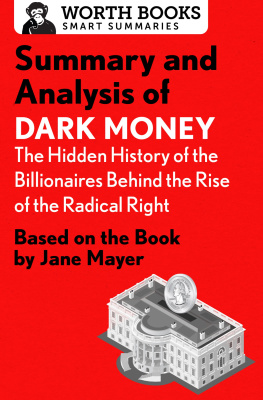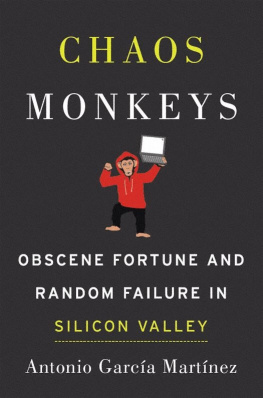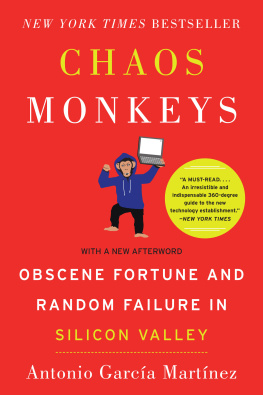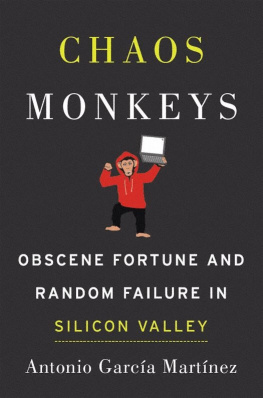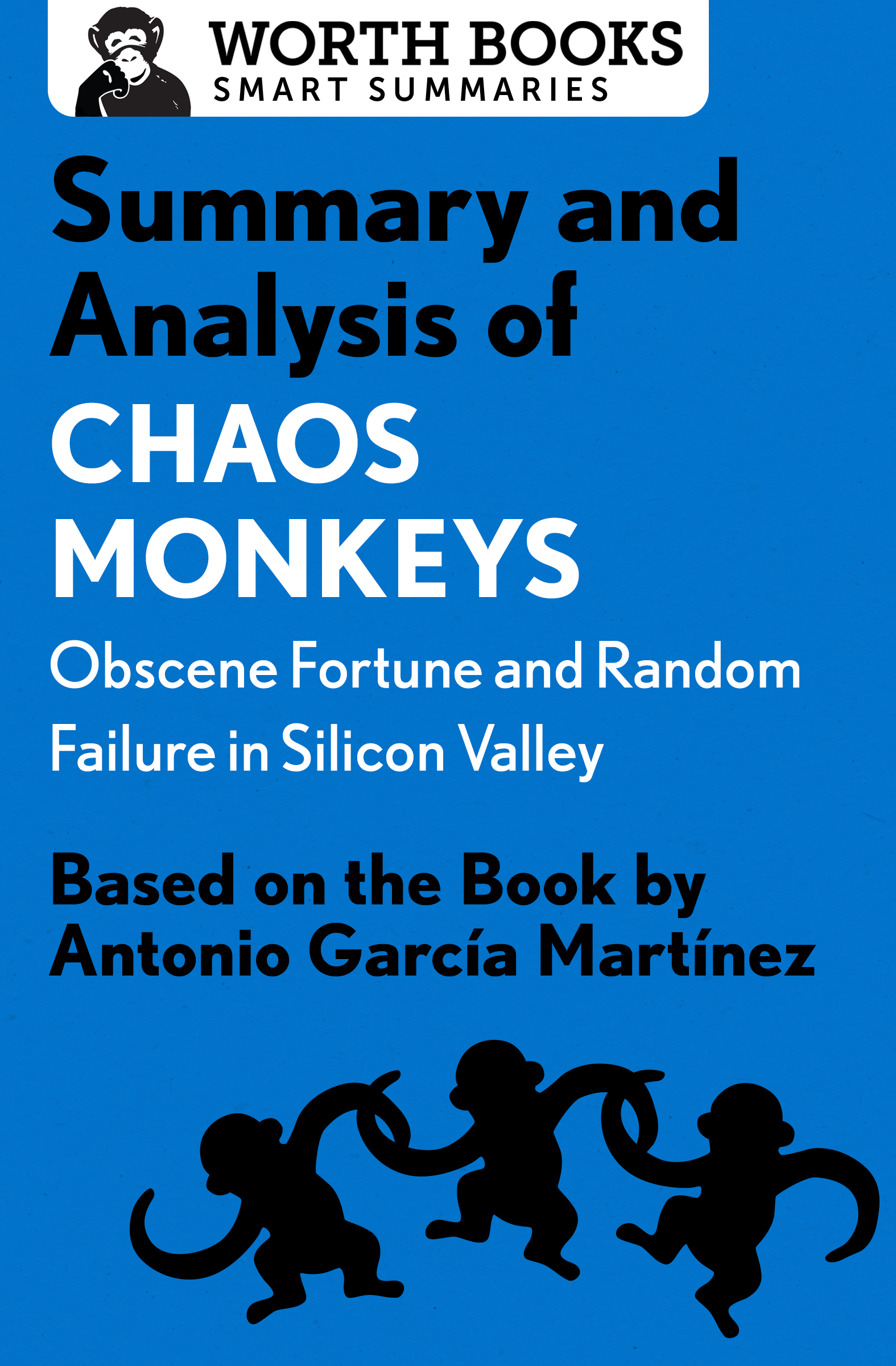Summary and Analysis of
Chaos Monkeys
Obscene Fortune and Random Failure in Silicon Valley
Based on the Book by Antonio Garca Martnez

Contents
Context
Chaos Monkeys is a contemporary historical account of a booming industry in which a quarter of the planet are now involved. Like it or loathe it, social media has enormously effected most peoples lives, and its helpful to know how it works. Ever since Facebook was founded in 2004, its dominated the social media scene; with visionary CEO Mark Zuckerberg at the helm, its changed the way in which people interact online.
Antonio Martnez is no stranger to high-risk enterprises, havingentered Goldman Sachs as a quantitative analyst, or a quant, in 2005. Restless,ambitious, and by his own admission anti-social, not even the cutthroat world ofinvestment banking is enough for him: he wants something more exciting, moredynamic. So he heads for the Bay Area to work at one of the myriad small techcompanies hustling to find a niche among the big corporationsor to sell out to oneof them. This is a commercial landscape dominated by tech giants Google, Facebook,and Twitter: Sooner or later, many little start-ups are likely to get sucked intotheir maw, and this is exactly what happens to Martnez and his colleagues. Landinga place with the seed accelerator Y Combinator, they develop their own product andTwitter snatches it. Martnez goes to work for Facebook and readers get to see thecompany from the inside: the panics, the strategies (or lack thereof), and thedriving competitive ethos that fuels this very capitalist enterprise under its youngand legendary CEO, Mark Zuckerberg.
Written in the first person, Chaos Monkeys has a feeling of immediacy, with a strong narrative drive and an engagingoften cynicalnarrative voice. Martnez knows his stuff, he doesnt pull any punches, and hes scathing about the chaos and the excesses of this still young, yet powerful industry.
Overview
Antonio Martnezformer physicist, Goldman Sachs quant, and entrepreneurarrives in the Bay Area in 2008 to join a tech start-up, an online advertising company called Adchemy. Hes in search of fortune if not fame, and the start-up scene is a good place to begin: California is booming with new tech companies, people, and ideas. Together with two colleagues, Martnez leaves Adchemy to set up a new project, AdGrok. He details the roller coaster experience of building a company and selling a business plan to potential investors. It doesnt go smoothly. The boys are sued by their former employer and are then poached by Twitter. In the end, avoiding a lawsuit by the skin of their teeth, Martnezs colleagues head off with a sigh of relief to the relatively calm environment of Twitter, while he opts instead to join the crisis-a-minute team on Facebook as an ads product manager.
Social media is a huge industry nowadays, but its often a mystery as to how it functions, and whether it actually makes any money. Martnez unpacks this mystery, explaining how Facebook gradually learns to monetize itself. He details his role in its anarchic advertising wing, while the rest of his life is meanwhile a mess of booze and sex. Facebook is an exciting, high-stakes company, with a lot of money riding on its success and failure, and although Martnez has bought into its brand of social awareness and mass communication, he rapidly comes to realize that not all is well within the company itself. CEO Mark Zuckerberg is an idealistic visionary, and as such, hes not all that interested in making moneyand he hates the idea of advertising. Martnez does his best, but the product he comes up with has a rival app in his own department, one that eventually wins the day. Martnezs job is terminated just before he quits, but with considerable irony given his earlier history, he is taken on by Twitter as a consultant. Having made a substantial amount of money, Martnez literally sails into the sunset on his new boat to reflect on his experiences.
Summary
Prologue: The Garden of Forking Paths
Martnez is sitting in one of the Facebook boardrooms, waiting for a meeting with the advertising department to begin. Were introduced to the main players at the companyincluding Mark Zuck Zuckerberg, Facebooks legendary CEO. Zucks rarely seen in the ads departmenthe doesnt really believe in it. His vision of Facebook is much bigger than merely making money: Zuckerberg believes in putting people together. But chief operating officer Sheryl Sandberg will be coming along to this meeting, too: a significant board member on whose approval the ultimate success of Martnezs campaign depends.
Martnez presents Facebook as a high-pressure company, rife with internal competition and dynamic personalities, a corporation willing to take risks. But if one of those risks doesnt pay off, the advertisers wont be pleasedtheyre the ones bankrolling the enterprise, after all. The atmosphere is tense, and there is almost no discussioneveryone is too busy checking their phones. Martnez is Facebooks first product manager for ads targeting, so turning ads into money is very much on his mind. As it turns out, Facebooks rich data isnt very good at being converted into targeted ads. So Facebook needs to follow its users around the net, looking at where they go and what they buy. But Zuck isnt interested in any of this. Eventually, however, he does give the goahead to combine Facebook with the outside Internet. Martnez is exhilarated. Hes on his way up the Facebook ladder.
Part One: Disturbing the Peace
The Undertakers of Capitalism
Flashback to November 2007 and Martnez is working for Goldman Sachs as a quant (a quantitative analyst), betting on the demise of companies and modeling credit derivatives. Goldman Sachs is a hyper-competitive world, the paradigm of a big investment bank. Its a testosterone-fueled environment in which the weak simply dont survive. Martnez explains how he eventually ended up in social media advertising: derivatives and ads are the same animal. Neither have any intrinsic valuetheyre not worth anything on their ownbut public perception of them can alter their value. Its about putting a price on human gullibility.
In 2007, Martnez is sick of trading and the bonus-obsessed culture of Goldman Sachs, just as he earlier became tired of academia. So, on a whim, he applies for a position as a research scientist in a mathematics-based form of advertising. Hes as surprised as anyone when the Silicon Valley companyAdchemyoffers him the job. He can see that difficult financial times are ahead on Wall Street, so he decides its time to leave. Hes off to California!
The Human Attention Exchange
Its 2008. Martnez is being interrogated by the police for drunk driving. He gets away with it, but its an illustration of the fast-paced, work-hard, play-hard world of tech startups that he now inhabits. Martnez explains how new social media advertising works: Theres a fraction of time between someone seeing an ad and buying the product. You have to find out how to appeal to potential consumers quickly, and enable them to buy the product as smoothly as possible. But the goal is the same as traditional advertising, Martnez tells us: to make you buy crap you dont need with money you dont have.
Knowing How to Swim
By 2010 its sadly obvious, however, that Adchemy is a failure. Martnez knows this because only the founder is still aroundthe sole, original member left standing. The company makes moneyso farbut has no actual product (it sells lists to organizations who really ought to be producing their own lists of customers). The CEO, Murthy Nukala, is abusive, and actually breaks one of Martnezs fingers by throwing a baseball at him without warning. However, Martnez and two of his colleagues have an escape plan: Theyre hoping to get into Y Combinator, a Bay Area boot camp for startups that offers a bit of funding and also helps pitching to venture capitalists. In return, Y Combinator gets equity in the startup if its successful.




